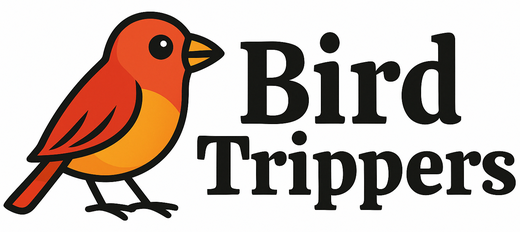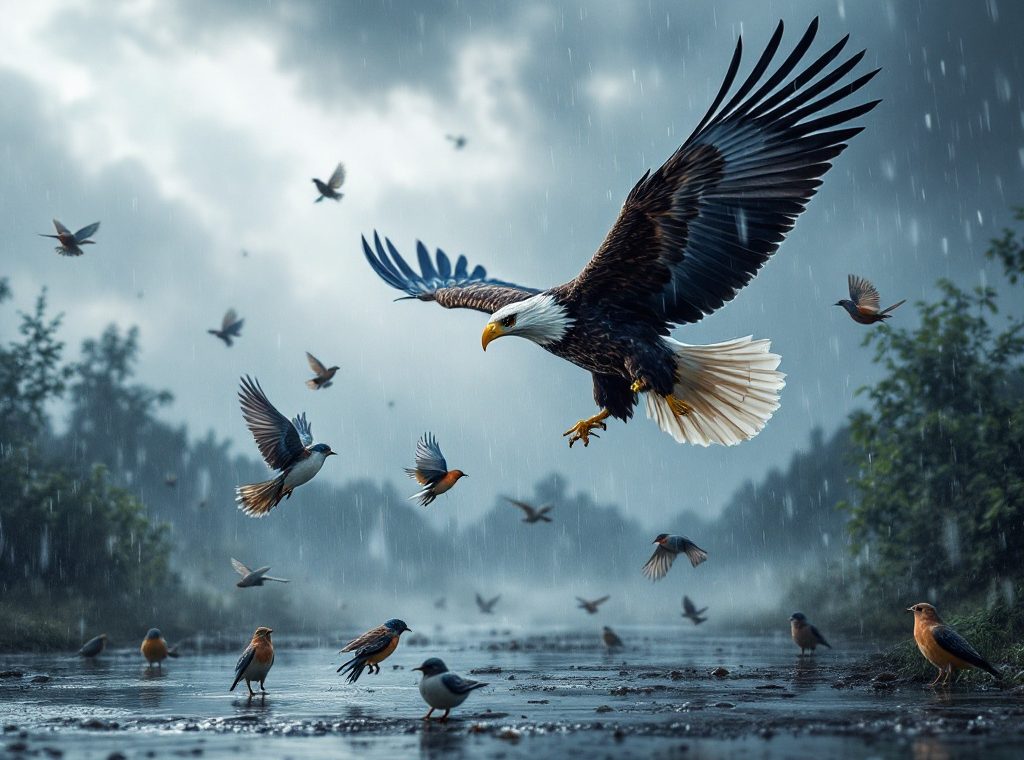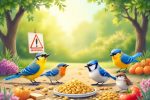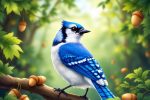Can Birds Fly in the Rain: Discover the Mystery of Flight
Ever wondered how birds manage to fly in the rain? Rain dramatically affects bird flight, creating challenges like reduced visibility and added weight from wet feathers. Discover how waterproof feathers, aerodynamic adjustments, and smart shelter-seeking strategies help birds survive even the heaviest downpours. Learn how different species, from tiny songbirds to majestic eagles, adapt to rainy conditions. Explore the fascinating world of avian resilience and learn how these feathered creatures conquer the skies, rain or shine. Fly into the article to uncover the secrets of bird flight in wet weather!
Important information
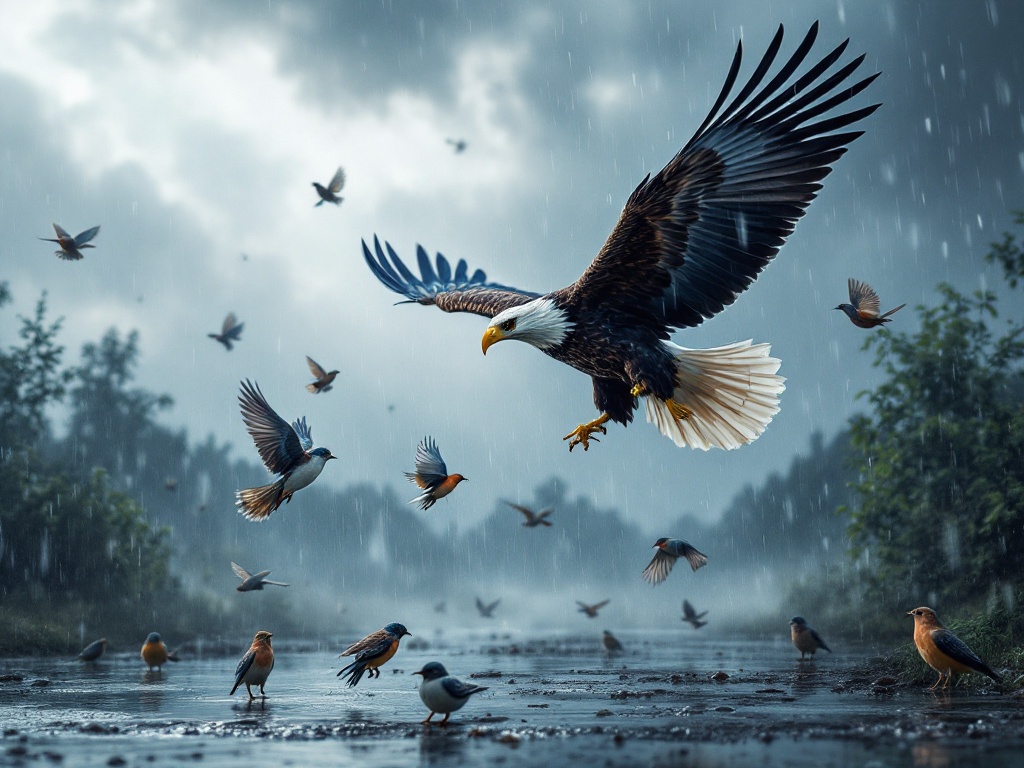
- Rain makes flying harder for birds, especially smaller ones, due to reduced visibility, added weight, and increased wind resistance.
- Birds have water-repellent feathers coated with preen oil, which helps keep them dry and able to fly in light rain.
- Different bird species react to rain differently; waterfowl are well-adapted, while songbirds often seek shelter during downpours.
- Birds adapt to rain by flying slower, lower, and adjusting their wing movements for better control.
- When it rains, birds seek shelter in various places, including trees, caves, and human-made structures.
Can Birds Fly in the Rain?
Rain significantly impacts birds in flight. The lower air pressure associated with rain creates challenging flying conditions. Small birds are especially vulnerable to heavy rain and strong winds. Although their water-repellent feathers offer some protection, a downpour can weigh them down and obstruct their vision. Ducks and herons, adapted to wet environments, cope better than birds from drier climates. Many birds seek shelter to protect themselves from severe storms.
What Challenges Do Birds Face While Flying in the Rain?
Rain presents several flight challenges for birds. Reduced visibility makes navigation difficult. The added weight of water on their feathers and increased wind resistance demand more energy. Wet feathers are less aerodynamic, making efficient flight tough.
How Does Rain Affect Birds’ Flight Patterns?
Rain significantly impacts bird flight, often grounding songbirds and preventing long journeys. Seeking shelter disrupts their usual flight patterns. However, the effect varies, and some species are more sensitive to rain than others.
Why Do Birds Prefer Not to Fly in the Rain for Long?
Rain significantly impacts a bird’s ability to fly. Soaked feathers add weight, making it harder to stay airborne. Reduced visibility impairs navigation, similar to looking through a blurry window. These factors increase the energy demands of flight, often prompting birds to seek shelter during heavy rain to conserve energy and improve safety.
The Mystery of Flight: How Birds Adapt to Rainy Conditions
Birds are masters of flight, even in the rain, thanks to their waterproof feathers. These specially structured feathers repel water, aided by preen oil from a gland near the tail. This oil, spread meticulously by the bird, creates a waterproof barrier, keeping them dry and flight-ready.
How Birds Fly in the Rain
A bird’s wing shape and flexibility are crucial for navigating rainy conditions. Adapting to the increased resistance, their wings maintain lift even when wet.
Impact of Rain on Flight
Rain does impact flight, causing birds to adjust their speed and trajectory. They might fly lower to avoid strong winds and slow down for better control in turbulent air. Altered wing movements further enhance stability, demonstrating their preparedness for rainy flights.
How Do Waterproof Feathers Help Birds?
Birds stay dry thanks to their uniquely structured, waterproof feathers. These feathers are coated with a special oil secreted from a gland near the bird’s tail, creating a water-repellent barrier. This allows water to bead up and roll off, which is vital for insulation and flight. Dry feathers prevent birds from becoming too heavy in the rain, enabling easier flight, and also help them stay warm. This natural waterproofing system is essential for a bird’s survival, allowing them to thrive in diverse environments.
What Role Does Aerodynamics Play in Bird Flight During Rain?
Rain increases air density, impacting bird flight. This requires them to adjust their wing movements to compensate for the decreased air pressure.
How Do Birds Adjust Their Airspeed in Wet Weather?
Rain significantly impacts bird flight, demanding adaptations in their aerial maneuvers. To maintain control amidst wet conditions, birds reduce their flight speed. They also modify their wing shape, subtly cupping them to enhance lift and stability. Furthermore, flight paths are altered, with birds often opting for lower altitudes or seeking shelter within trees. These crucial adaptations enable them to navigate the challenges posed by rain.
Adaptations in Different Bird Species
Waterfowl, such as ducks and geese, are naturally equipped for flying in the rain. Their water-repellent feathers and aerodynamic bodies allow them to navigate through wet conditions effectively.
Smaller birds, like songbirds, typically seek shelter during rainfall. Rain significantly hinders their flight, making it difficult for them to stay airborne.
Swallows can handle light rain or drizzle, but heavy downpours often ground them. They are not as well-equipped as waterfowl to fly in substantial rainfall.
Larger birds of prey, such as eagles and hawks, face different challenges in the rain. The added weight of water on their feathers makes flight more strenuous, disrupting their ability to soar efficiently. A rain-soaked eagle, for instance, might struggle to stay aloft.
Why Are Ducks and Geese Better Suited for Rainy Flights?
Ducks and geese exhibit remarkable flight proficiency in rainy conditions due to several adaptations. Their feathers possess a unique structure and a preen oil coating that effectively repels water, preventing the added weight and aerodynamic inefficiency associated with waterlogged feathers. The shape and arrangement of their wings generate substantial lift, even in wet conditions. Furthermore, these birds demonstrate behavioral adaptations, flying at lower altitudes to mitigate the impact of strong winds and turbulence.
Can Swallows Fly in Light Rain?
Swallows are resilient birds, demonstrating their adaptability by hunting insects in light rain. This showcases their ability to fly effectively even in damp conditions.
How Do Song Birds React to Rain?
Heavy rain grounds songbirds, forcing them to find shelter and making long flights impossible. This behavior is a safety mechanism.
Why Do Some Large Birds Struggle to Fly When Wet?
Heavy, wet feathers hinder the flight of large birds, such as vultures, making takeoff and soaring difficult.
Birds’ Strategies for Protection and Shelter
When rain falls, birds seek shelter in various locations. These include: dense vegetation offering excellent cover, caves providing a safe retreat, human-made structures (such as eaves or birdhouses) becoming temporary refuges, nests protecting vulnerable eggs and chicks, and trees shielding birds from the downpour with their canopies and leaves, while their cavities offer secure hiding places.
Where Do Birds Take Shelter When It Rains?
Birds seek refuge in diverse locations, such as the dense cover of trees and shrubs, the natural shelter of caves, and even human-made structures like eaves and birdhouses. These nests offer protection from rain, keeping the birds dry and secure.
How Do Birds Use Nests and Trees for Protection?
Trees and their leafy branches shield birds from wind and rain. Nests, nestled within these branches, offer dry shelter and a safe haven for raising young, hidden from predators. However, not all birds nest in trees. Some birds, like burrowing owls, adapt to different environments. They dig nests in the ground or find refuge in cliffs. This demonstrates the remarkable adaptability of birds in finding safe and dry shelter.
